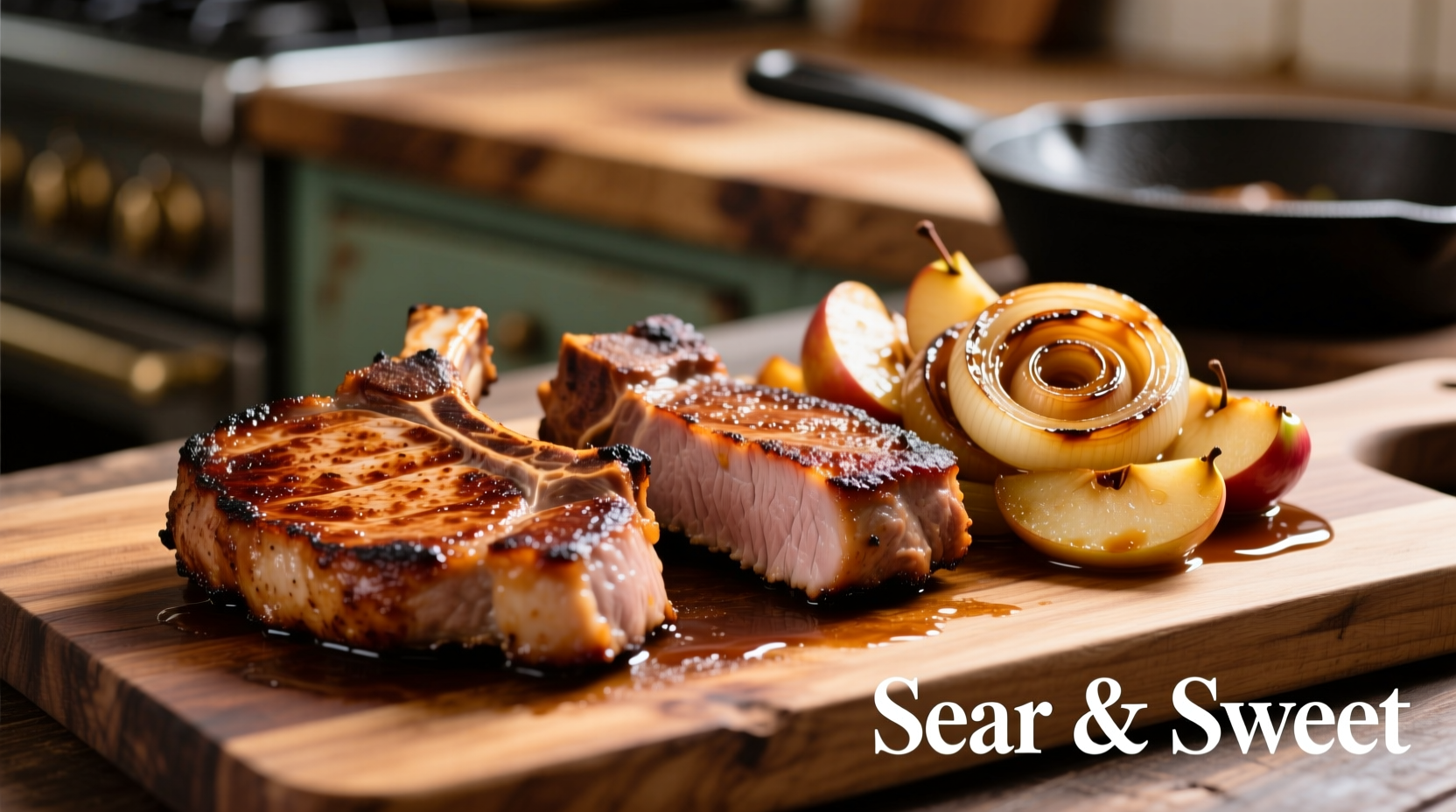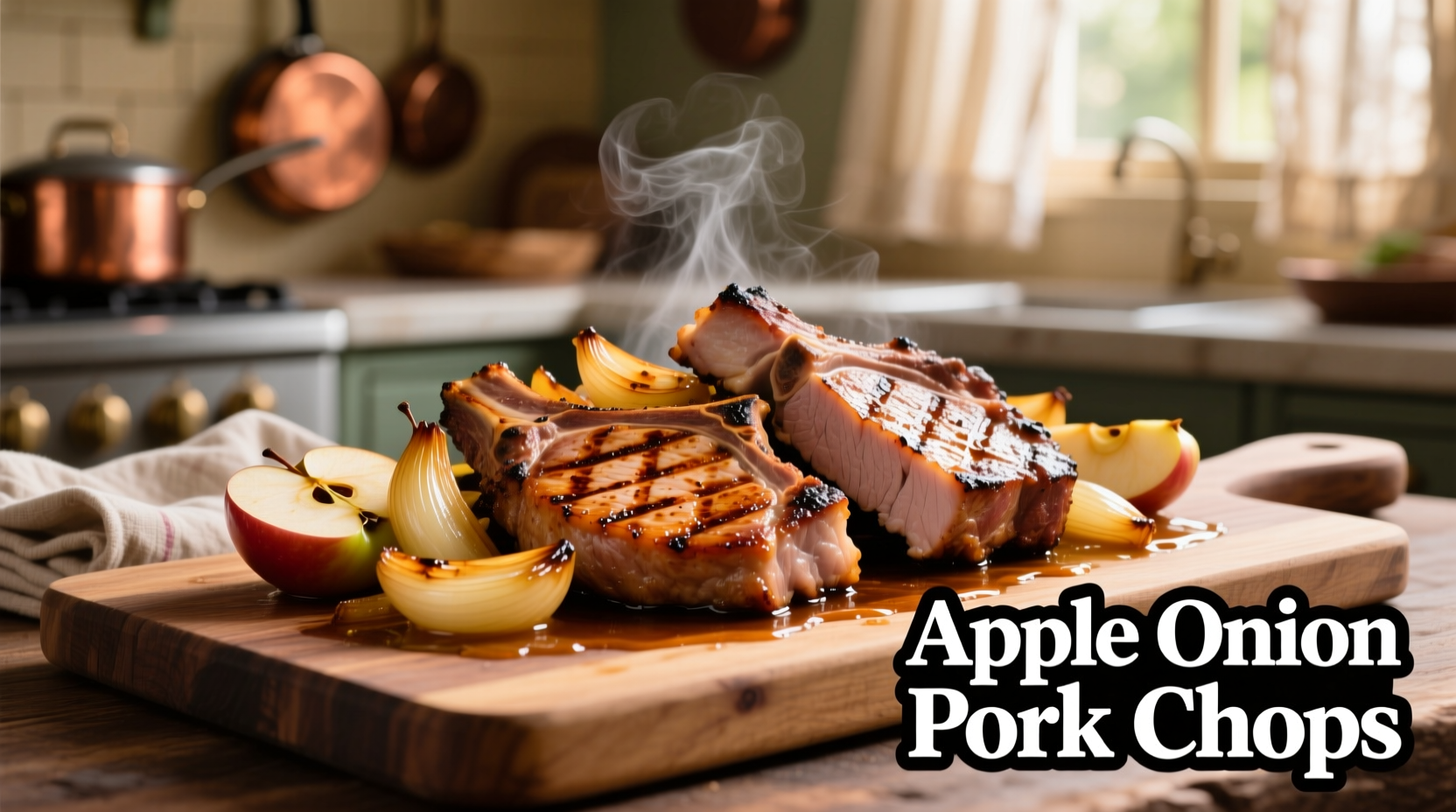Apple onion pork chops combine tender pork chops with sweet apples and caramelized onions for a balanced meal ready in under 30 minutes. This classic dish features perfectly seared pork chops topped with sautéed apples and onions that create a natural pan sauce, offering optimal protein, fiber, and flavor in one skillet meal.
Discover why this simple yet sophisticated combination has stood the test of time in home kitchens across America. Whether you're cooking for weeknight dinner or special occasions, this dish delivers restaurant-quality results with minimal effort. We'll walk you through the perfect technique for juicy pork chops every time, plus professional tips that transform basic ingredients into something extraordinary.
Why Apple and Onion Complement Pork Chops Perfectly
The magic of apple onion pork chops lies in the science of flavor pairing. Pork's mild richness serves as the perfect canvas for sweet and savory elements. When apples hit the hot pan, their natural sugars caramelize, creating complex flavor compounds that enhance pork's umami notes. Meanwhile, onions undergo the Maillard reaction, developing deep, savory-sweet flavors that bridge the gap between the fruit and meat.
According to culinary research from the Culinary Institute of America, the malic acid in apples cuts through pork's richness while complementing its natural sweetness. This creates a balanced flavor profile that satisfies multiple taste receptors simultaneously. The combination also provides nutritional synergy—apples contribute fiber and vitamin C while pork delivers complete protein and essential B vitamins.
| Ingredient | Flavor Contribution | Nutritional Benefit |
|---|---|---|
| Pork chops (bone-in) | Rich umami, mild sweetness | Complete protein, zinc, B12 |
| Apples (firm varieties) | Bright acidity, natural sweetness | Fiber, vitamin C, antioxidants |
| Yellow onions | Complex sweetness when caramelized | Quercetin, vitamin C, prebiotic fiber |
Essential Ingredients Selection Guide
Not all pork chops or apples work equally well in this dish. Professional chefs recommend selecting ingredients based on specific criteria that directly impact your final result.
Pork Chop Selection: Choose bone-in, center-cut loin chops about 1–1.5 inches thick. The USDA Food Safety and Inspection Service recommends cooking pork to an internal temperature of 145°F (63°C) followed by a 3-minute rest. Thicker cuts prevent overcooking during the searing process. Avoid "enhanced" pork chops injected with sodium solutions, as these create excess moisture that prevents proper browning.
Apple Varieties: Opt for firm-textured apples that hold their shape when cooked. Honeycrisp, Braeburn, or Pink Lady varieties provide the ideal balance of sweetness and tartness. According to research from Washington State University's Tree Fruit Research & Extension Center, these varieties maintain structural integrity while developing complex caramelized flavors during cooking.
Onion Choices: Yellow onions offer the best balance of sweetness and pungency for caramelization. Their higher sugar content (approximately 4-5% by weight) creates richer flavor compounds compared to white or red varieties.

Step-by-Step Cooking Process
Follow this professional technique for restaurant-quality results every time. The key is proper temperature control and timing—common pitfalls include overcrowding the pan and flipping too soon.
- Preparation (5 minutes): Pat pork chops completely dry with paper towels. Season generously with salt and freshly ground black pepper. Cut apples into 1/4-inch slices and onions into 1/2-inch wedges.
- Searing the Pork (6-8 minutes): Heat 1 tablespoon of oil in a heavy skillet over medium-high heat until shimmering. Place pork chops in the pan without touching. Resist the urge to move them for 3-4 minutes until a deep golden crust forms. Flip and cook 3-4 minutes more. Transfer to a plate.
- Cooking Apples and Onions (8-10 minutes): Reduce heat to medium. Add 1 tablespoon butter to the same pan. Add onions and cook 5 minutes until starting to soften. Add apples and cook 3-5 minutes until tender but still holding shape.
- Finishing (3-4 minutes): Return pork chops to the pan, nestling them among the apples and onions. Cook 2-3 minutes to reheat pork and allow flavors to meld. Optional: Add 1/4 cup apple cider or chicken broth to create a light pan sauce.
Timeline for Perfect Execution
Timing is critical for optimal results. This visual timeline shows the precise sequence for coordinating all elements:
-5 minutes: Prepare ingredients (dry pork, slice apples/onions)
0 minutes: Heat oil in skillet, season pork
3 minutes: First flip of pork chops
7 minutes: Transfer pork to plate, add butter to pan
12 minutes: Add apples to onions in pan
17 minutes: Return pork to pan with apples/onions
20 minutes: Check pork temperature (145°F)
23 minutes: Remove from heat, rest 3 minutes
26 minutes: Serve immediately
Avoid These Common Mistakes
Even experienced home cooks make these critical errors that compromise results:
- Wet pork surface: Moisture prevents proper browning. Always pat chops completely dry before seasoning.
- Incorrect pan temperature: Oil should shimmer but not smoke. Too hot causes burning; too cool creates steamed rather than seared meat.
- Overcrowded pan: Causes temperature drop and steaming instead of searing. Cook in batches if necessary.
- Early flipping: Wait until pork releases naturally from the pan (about 3-4 minutes) before attempting to flip.
- Overcooked apples: Add apples later in the process to maintain texture. They should be tender but still hold their shape.
Serving Suggestions and Variations
While classic apple onion pork chops shine on their own, these professional pairing suggestions elevate the meal:
Pair with roasted Brussels sprouts or garlic mashed potatoes for a complete meal. A crisp green salad with apple cider vinaigrette complements the richness. For wine pairing, choose a medium-bodied white like Chardonnay or a light red like Pinot Noir.
For dietary variations:
- Gluten-free: Naturally gluten-free—just ensure any broth used is certified GF
- Dairy-free: Substitute olive oil for butter when cooking vegetables
- Lower sugar: Use Granny Smith apples for more tartness and less natural sugar
Storage and Reheating Tips
Proper storage maintains quality for leftovers. The USDA recommends refrigerating cooked pork within 2 hours of cooking. Store in an airtight container for up to 3-4 days.
For best reheating results:
- Oven method: 325°F for 10-15 minutes covered with foil
- Stovetop: Gentle reheating in skillet with splash of broth
- Avoid microwave: Creates uneven heating and rubbery texture
Freeze portions for up to 2 months. Thaw overnight in refrigerator before reheating. Never refreeze previously frozen cooked pork.











 浙公网安备
33010002000092号
浙公网安备
33010002000092号 浙B2-20120091-4
浙B2-20120091-4